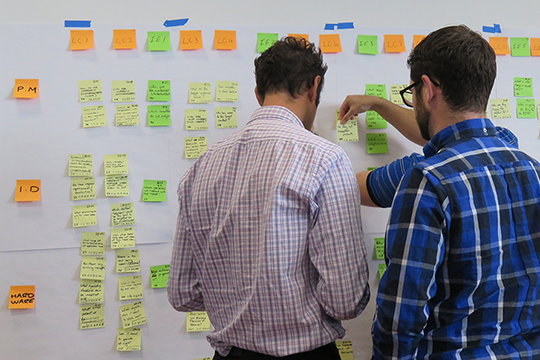Sometimes when I travel, I carry a penny whistle with me, because it’s lightweight and cheap. I don’t have to worry about the airlines or thieves. They were developed by Robert Clarke in the 1840s, who figured out how to use mass production techniques to make simple fipple flutes out of rolled tin, and the original model cost just a penny. Today, whistlers use them most often for traditional Irish music.
Relative to most instruments, penny whistles are easy to play, with a simple six hole fingering system and a forgiving mouthpiece. If I’m by myself, I can just improvise and have a great time. Just about any combination of notes sounds good. But if I want to play with anyone else, I have to work a lot harder. We need to be in sync on the rhythm, and I need to make sure that I hit the right notes at the right time. We need to understand and blend our styles so that the music is coherent.
We would never expect a group of musicians to perform the easiest of music without at least some time to warm up together. Yet so many companies throw teams together and send them off without giving them any time to get used to each other, and get aligned on the program. Kickoff events require some investment up front, but the team reaps the benefits for the life of the program. You can scale the size of the Kickoff to the size of your objectives, but if you want to give your program the best chance of success, the Kickoff Event is the one meeting to invest in.
Five Reasons Why Your Program Needs a Kickoff Event
A Kickoff Event is a one to two day event for the whole team, ideally held away from the office. During the formal part of the event, the team aligns itself on the goals, overall schedule and the plan. They will leave this meeting knowing what they are going to do when they get back to their desks. During the informal part of the meeting – the lunches, coffee breaks and perhaps dinner or team-building event, the team will get to know each other better, which will make it much easier for them to work as a team. If your team is of any size, or you have remote team members, this will require some planning and room in the budget. Here are five reasons why this investment is worth it:
Build alignment on the overall program goals, major milestones and Core Hypotheses.
At any Kickoff event, the first order of business is to introduce the program to the team, and give them the opportunity to ask questions about the overall direction of the program, its strategic fit, major milestones and targets, and the Core Hypothesis that’s driving the need for a new product or new business initiative. When everyone is in the room at the same time, they all receive the same information. If anyone on the team has difficulties with the objectives, they have a place to raise their concerns before they dive in. When the team is aligned on the goals of the program, it’s much easier for them to make decisions.
Build relationships among team members to speed communication and build trust.
During the formal sessions and during all the unstructured time that occurs around them, the team is getting to know each other. During the breaks they get a chance to ask each other questions, share pictures of their kids or latest vacations, and talk about their interests. These conversations help build stronger teams that are more likely to look out for each others’ interests.
Develop a solid plan for the next phase of development.
No matter how you intend to structure the work of your team, the program will work better when the team owns the plan. The team will spend most of its time at the event building their plan, at least the plan to reach the next major milestone. Normally, the project or program manager owns the plan — but then the plan is the manager’s plan, and not the team’s plan. When the team builds the plan together, they understand how the pieces fit together. They also feel stronger personal commitment to it, and more ownership of the things they need to do to fulfill the plan.
A Kickoff Event is essential for the success of the Rapid Learning Cycles framework. Everyone on the team needs to understand how you have adapted the Rapid Learning Cycles framework, and the Key Decisions and Knowledge Gaps they are responsible for. There is no written document you can create that takes the place of the discussion that goes into the plan. It would take weeks to try to communicate the results without getting everyone in the same room. Teams that attempt to use the framework without this step have expended a lot of wasted energy struggling to get coordinated. If you try to set up a Rapid Learning Cycles framework without a Kickoff Event, don’t be surprised when it all falls apart within a quarter.
Ensure that everyone has the same understanding about the team’s working methods.
As the team builds the plan, they are making agreements with each other about how they will work together: what needs to be done together, and what can be worked independently, where the interface points will be, how meetings will be run and how knowledge will be shared. They will all leave the room knowing not just what they are going to do but how they are going to do it.
Surface problems in your working assumptions, especially around areas of integration.
Often, the Kickoff Event is the first time that many of the team members have spent much time thinking about the program, and it may be the first time you have an opportunity to share the program with new functional areas. We often find that these meetings surface problems and flag issues that would not have come out without the dedicated time to think the program through.
Program Kickoffs Are Face to Face Meetings
If you are prepared to invest thousands or millions of dollars in development, then you should be willing to spend a few thousand more to get the team together in one place to get aligned, build relationships and develop a good plan.
The team will use paper charts, whiteboards and sticky notes in this meeting, the easiest tools for visual collaboration, requiring no technology more advanced than a permanent marker. The plan gets developed through a participative process that builds working relationships, surfaces conflicts when they are easiest to resolve and helps the team internalize the structure of the product and the team framework. Communication is much better after people have gone back home, and the relationships endure throughout the project.
While I was still at Hewlett Packard, a long-planned face-to-face Kickoff for a global project was cancelled due to an end-of-fiscal-year travel freeze, a corporate-wide last-ditch effort to cut expenses before the final numbers came in. We attempted to hold a “Kickoff” as a series of web conferences, but people didn’t know each other well and had divergent views of the project’s goals.
There was a lot of conflict that was obvious in hindsight, but entirely hidden because we were not in the same room. This remote “Kickoff” left us with a muddled, confusing charter that reflected the team’s misalignment. The project never recovered, and three teams spent two years working against each other. By the time the program manager was able to bring the teams together to resolve the conflicts, it was too late to save the project. To this day, I am convinced that if we had only been able to resolve our differences from the beginning, through building relationships and developing a strong charter as a team, we could have delivered a great product. Instead, to save less than $20,000 in travel costs, the company wasted more than $10 million of development costs.
Despite this experience, I have tried to run Kickoff Events like this remotely, using some of the best videoconferencing systems out there to do it. But the fact remains that the people who are not in the main room with the Program Leader are largely shut out of the process, no matter what we do. At events like this, the best ideas often emerge during morning coffee, lunches and breaks. A lot of informal lobbying takes place at the espresso machine, leaving the person on the video screen shut out of the real decisions.
After watching teams struggle again and again, I will no longer make the effort. If you believe in the product, and in the people who will help you build it, and if you want to see it come to life as quickly as possible, this one face-to-face meeting is worth every penny you spend on it, and every night away from home.
A Coordinated Team with Momentum
Once the Kickoff Event is over, you need to sustain the momentum by publishing the program documentation as soon as you possibly can — within 24 hours if at all possible. Chances are, you have email piled up and a full slate of meetings but this has to take priority.
On a complex project, it’s so easy for people to walk away from a meeting with a different understanding of the agreements that have been made, and without a reference, people get off track quickly. This can burn up a lot of time. When the team gets fast access to the plan they have built, they will maintain the alignment that they took out of the room.
When your team gets back to the office, they will know exactly what they need to do to get the program moving. When they all take their places on the team, they’ll be prepared to stay in sync and blend their styles to deliver a coherent product.



